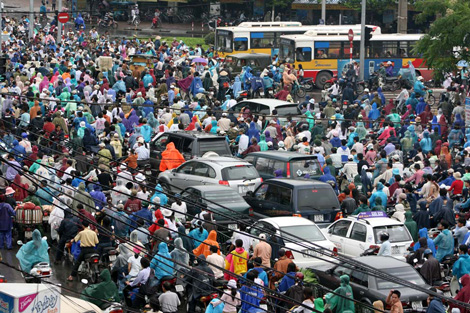>> Expert claims Hanoi is capable of curbing traffic congestion
>> Hanoi urged to curb traffic congestion
The majority of offices and schools in Hanoi are located in the inner city, a situation that has been blamed for traffic problems in a city with an increasing number of vehicles.

Students, teachers and employees account for 70% of Hanoi’s traffic
At a seminar to discuss solution to the capital city’s traffic system, Nguyen Ngoc Quang, from Twente University in the Netherlands, said that up to 68% of offices and schools are located in the inner city while only 7% are located in outlying districts.
In the meantime, motorbikes currently account for over 80% of commutes in the city and Hanoi is forecast to see a boom in private cars during 2010-2030 period, Quang noted.
“One major cause of traffic congestion in the capital city is the location of too many universities and schools in the inner city,” said Associate Prof. cum Dr. Vu Thi Vinh, Deputy General Secretary of the Vietnam Urban Association.
Dr. Vu Thi Vinh explained that, in order to improve the traffic situation, residential areas and other support services are often arranged nearby their schools, adding to the dense population in the city’s centre. Commutes by students, teachers and employees account for 70% of traffic flow in the city.
“Hanoi currently houses around one million students, in addition to a large number of teachers and lecturers. Add to this food and other services, the result is rapid growth in population in a small area, This has bad effects when it comes to the transportation system,” she emphasised.
According to Vinh, when some parts of these institutions are relocated to the surrounding areas, it will help ease population density and traffic problems in the city’s centre, while contributing to the development of the targeted locations.
“If residents in the surrounding areas can find a good job, they may not need to travel daily into central Hanoi. Also, if students go to universities outside of Hanoi, there be more job opportunities in these outlying areas, further easing traffic,” she added.
Under the city’s master plan through 2030 with a vision for further development through 2050, approved by the Government, Hanoi plans to build five satellite urban areas including Hoa Lac, Son Tay, Soc Son, Xuan Mai and Phu Xuyen. It will also develop three ecological urban areas in Phuc Tho, Quoc Oai and Chuc Son.
The building of these new satellite areas is expected to take off some of the burden put on the city's centre in terms of housing, training, trade, industry and other services.
However public concerns have raised over the feasibility of the plan, as it has been approved for a decade and there has been little to no headway.
Apart from the construction of 'satellite cities', in the opinions of some experts, Hanoi should better coordinate with existing cities such as Hai Duong, Hung Yen, Bac Ninh, Vinh Yen, Phuc Yen and Phu Ly in order to ease the current overload, Quang added.

Leave your comment on this story